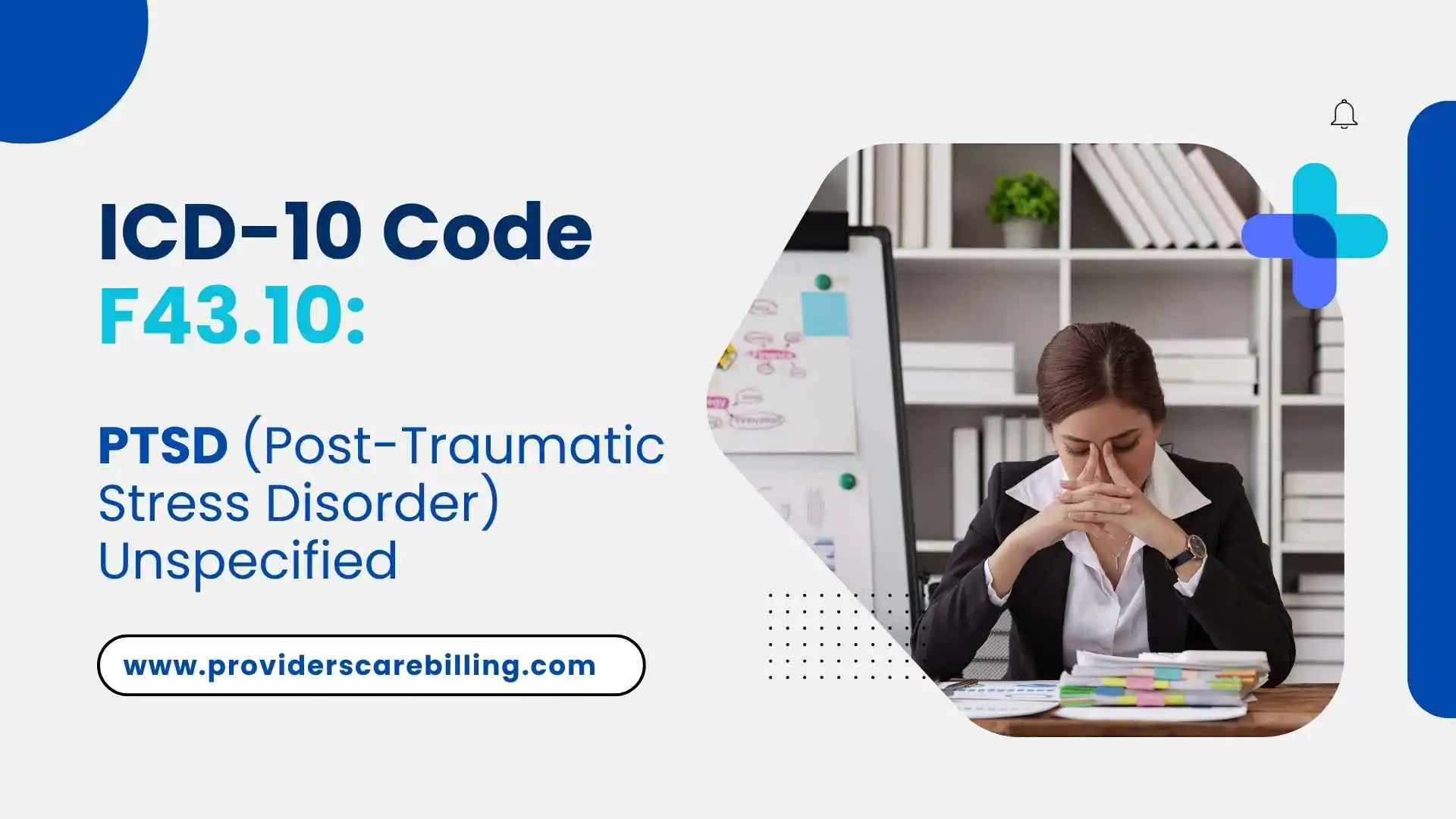Post-traumatic stress disorder is a mental health condition that could harshly affect you if you have faced a traumatic or alarming event. This could have happened from a serious accident, natural disaster, combat, physical abuse, or any other situation where you could feel intense fear or helplessness.
While PTSD is well known, you will not realize that it’s also something that needs to be recorded properly in medical records using something called an ICD-10-CM code. One of those important codes is F43.10.
In this article, we will discuss the F43.10 diagnosis code, its use in health care, and its importance, especially in areas such as physical therapy and mental health treatment.
What is the ICD-10-CM Code?
First, we will understand the ICD 10-CM code before we jump into the details of F43.10.
In this ICD-10-CM, where ICD stands for “International Classification of Diseases.” In this code, the “10” stands for the 10th edition, and “CM” is abbreviated as “Clinical Modification.” As we know, there is a long list of medical diagnosis codes that are used in the whole world for the purpose of tracking diseases and health conditions.
You can take it as a universal language in the healthcare world. Because all insurance companies, nurses, therapists, and doctors use this type of code to describe the condition of the patients.
What Does F43.10 Stand For?
Now let’s talk about F43.10. This code is specifically used for chronic post-traumatic stress disorder. So, if you see this F43.10 code in someone’s medical record for the next time, it means they have been diagnosed with PTSD.
This F code and PTSD are part of a major group of mental health codes. The letter “F” in “F43.10” indicates that it is related to the section for mental and behavioral disorders. That’s why you might hear many times from doctors or billing specialists which talks about “codes F” when they’re recommending mental health issues.
Why the F43.10 Code Matters
You may be wondering—why is it even important to have a code for PTSD? Here’s the thing. Accurate coding helps with:
- Getting the right treatment
- Receiving insurance coverage
- Tracking health statistics
- To recommend specialists, whether they be therapists or physical therapists, for patients.
For recommended support to give patients, you need to use a valid diagnosis code for PTSD. On the other hand, insurance companies are also often required to provide these codes to approve services, medications, or therapy sessions. That’s why correct PTSD coding can truly make a clear difference in someone’s recovery.
F34.1 – Dysthymic
Another code, F34.1, closely resembles F43.10, but it is the ICD-10 code for Dysthymic disorder, also known as Persistent Depressive Disorder. It is a chronic mood disorder characterized by a depressed mood that lasts for at least two years. Symptoms are less severe than those of major depressive disorder but can still significantly impair daily functioning.
PTSD in Physical Therapy?
Starting to connect PTSD with physical therapy may sound strange. But with time, there’s a strong connection between mental and physical health. Most people with PTSD also suffer from chronic pain, muscle tension, or physical injuries which connected to their trauma.
After this, the ICD-10 code for PTSD physical therapy comes into play. Physical therapists may also take care of both physical symptoms and emotional stress. By using the F43.10 code, therapists can understand the whole scenario of what the patient is suffering from.
By way of example, a veteran with PTSD might also have back pain or injuries from the start of their service. The physical therapist would need to include the patient’s ICD-10 codes, not just for the pain, but also for the PTSD. In this way, both mental and physical health are addressed during treatment.
How PTSD Becomes Chronic?
There are different reactions of people to trauma. In which some people take the symptoms of PTSD to end over time, but for others, it lasts for a time as painful memories and reactions. When PTSD remains for a long time and continues to impact someone’s daily life, it will be considered chronic PTSD.
This is the actual time to use the ICD 10 code for PTSD chronic (F43.10). Here are some common symptoms of chronic PTSD:
- A person will face nightmares or flashbacks
- People should stay away from people or places that remind them of trauma.
- The affected person always feels numb or emotionally distant
- Not concentrating and not sleeping well
- Feel anger outbursts and experience mood swings
- Always remains in depression and anxiety
If you do not treat these symptoms for a while, they will remain for a long time. In this regard, proper support and diagnosis will be important.
Using the Code in Real Life
Let’s look at a few real-life situations where the F43.10 diagnosis code is used:
1. Mental Health Counseling
A therapist will be working with a patient who was in a serious car crash about five years ago. The patient is not in normal condition, still has nightmares, is not driving, and has panic attacks. The therapist is using the code for PTSD (F43.10) to describe the diagnosis. This will help the therapist bill the sessions properly and coordinate care.
PTSD often coexists with other behavioral health concerns, such as substance use disorders. For instance, providers may also need to reference ICD-10 Code F10.239 when treating patients experiencing both PTSD and alcohol withdrawal symptoms.
2. Physical Therapy After Abuse
A woman is referred to a physical therapist after years of physical abuse left her with both PTSD and neck pain. The therapist uses the ICD-10 code for PTSD physical therapy in the documentation, along with other codes for physical injuries. This gives a more complete view of the patient’s needs.
3. Veterans Affairs Clinics
Mostly, veterans may be experiencing PTSD after combat. When they go to the VA for help, their health team might use F43.10 as the diagnosis code for PTSD for different purposes. It includes starting therapy, providing medication, or even approving their disability claims.
Final Thoughts
Post-traumatic stress is more painful than just a diagnosis. Actually, it is a hard experience that affects millions of people. And if the idea of medical coding might seem tough or complicated, it’s a major part for people to make sure they get the care they need.
By choosing the right code F43.10 specific for diagnosis, which plays a vital role in treating you to get better treatment, therapy, or hospital care, this code for PTSD will also ensure all the stakeholders are on the same page.
If you are suffering from PTSD, don’t fumble or late to reach out to a medical or mental health specialist. By proper diagnosis and the use of the right codes like F43.10, relief and hope for you are truly possible.




